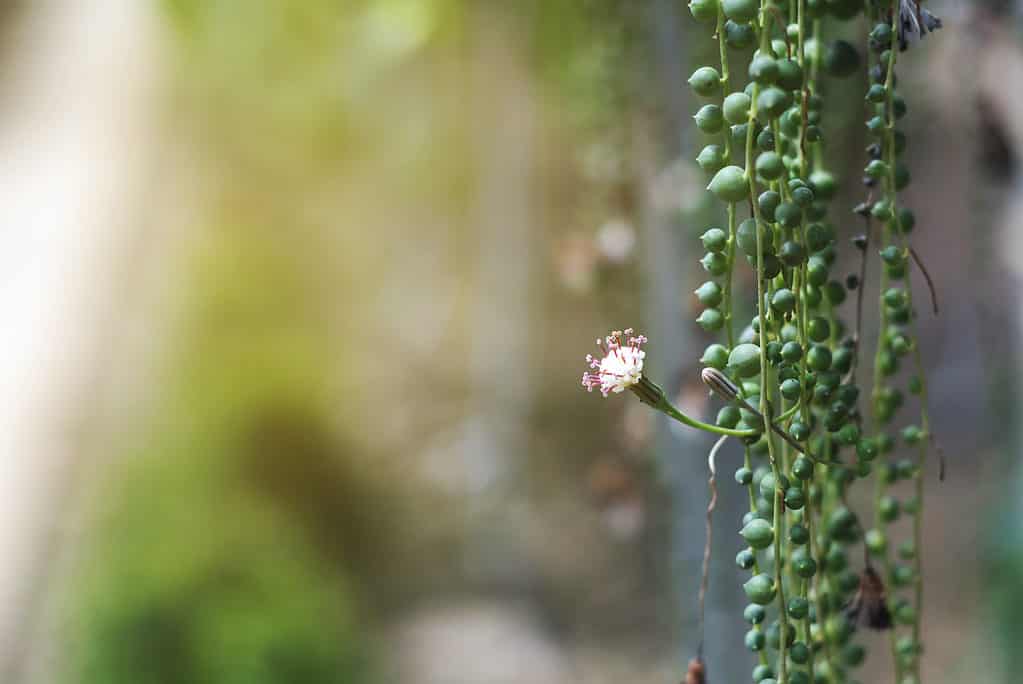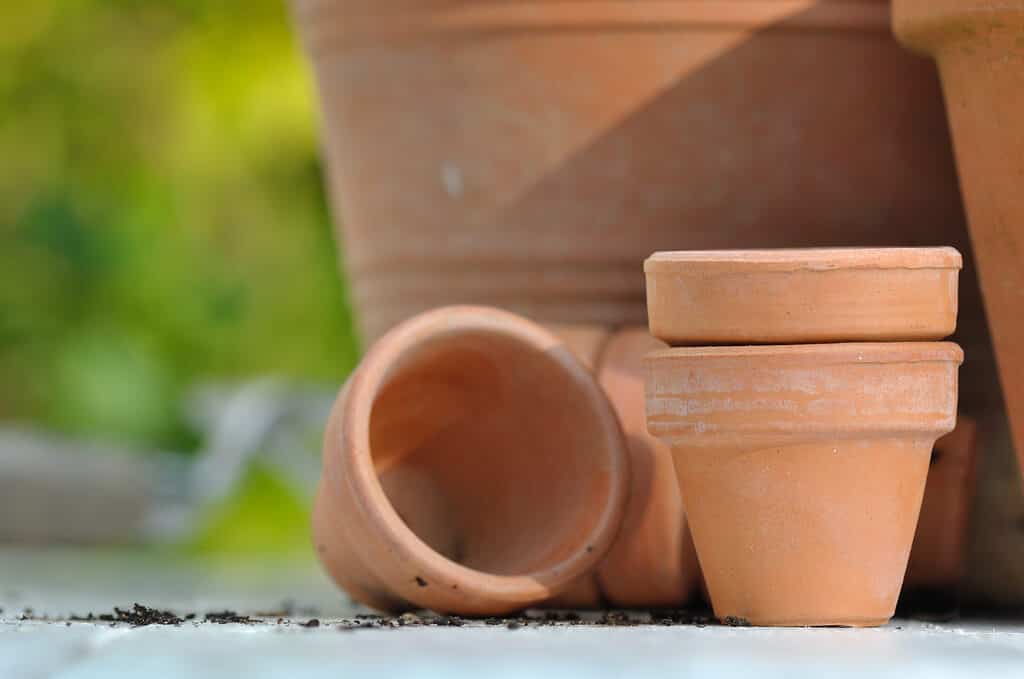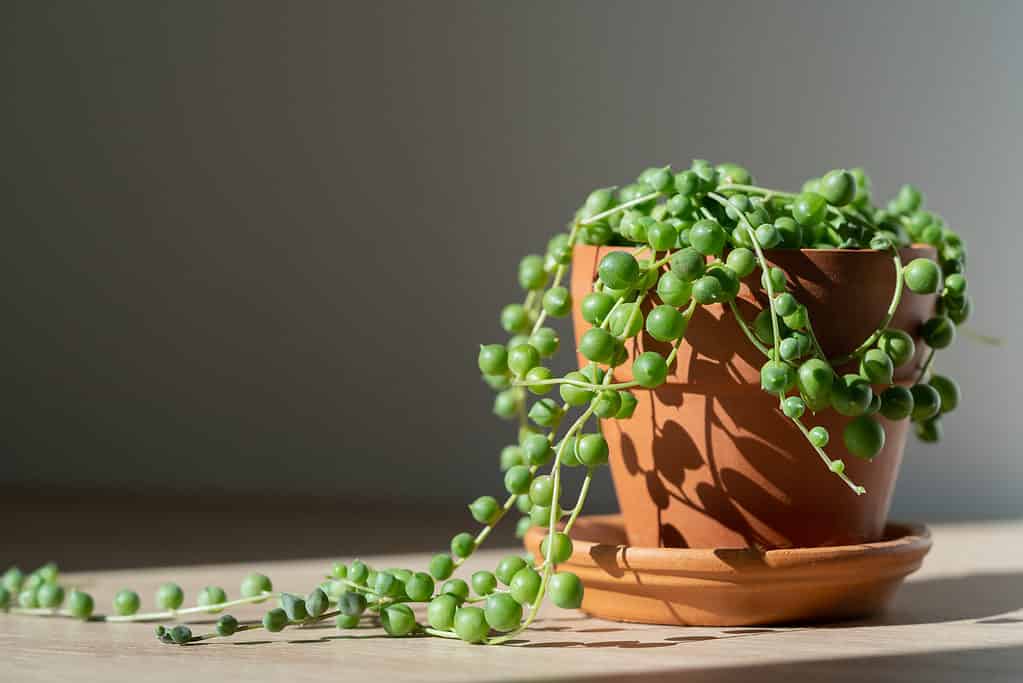The string of pearls plant is a perennial, creeping, succulent vine endemic to the Eastern Cape province of South Africa. The plant creeps along the ground in the wild and forms dense mats.
When grown as a houseplant, the stems with their iconic pearl-shaped leaves spill over the side of the hanging basket or planter.
It blooms in the summer months with clusters of small white flowers that have a sweet cinnamon-like scent.

The small white flowers have a sweet cinnamon-like scent.
©iStock.com/Cn0ra
Different varieties of this trailing succulent include the string of pearls, string of tears, purple string of beads, and variegated string of pearls.
The string of pearls, which thrives in dry environments, is a popular houseplant due to its ease of care. Here are the details to help you succeed in propagating this beautiful plant.
| String of Pearls Facts | |
|---|---|
| Botanical name | Senecio rowleyanus |
| Common Names | String of pearls, string of beads, string of peas, rosary vine |
| Sunlight | 6-8 hours daily |
| Soil | Sandy, well-drained |
| Water | Once every two weeks. Do not overwater! |
| Indoors or Outdoors | Indoors in a sunny window. Outdoors in Zone 9 and above. |
Sunlight
The string of pearls plant needs a minimum of 6 hours of sunlight daily. Direct sunlight in the morning works well, but indirect is best during the more intense afternoon sun.
Soil Type
Because the string of pearls is prone to root rot, drainage is vital. Sandy soil is the best choice, but any well-draining succulent potting soil will work. A prepackaged cactus potting mix is a good option, but you can also create your own with a 3-1 ratio of potting soil to sharp sand.
Containers should have adequate drainage holes. Terracotta and unglazed ceramic pots are optimal choices since they draw moisture out of the soil.

Terracotta pots are great for propagating string of pearls.
©iStock.com/sanddebeautheil
Water
One of the most common mistakes in caring for a string of pearls plant is overwatering. As it is native to dry areas of South Africa, this plant only requires watering once every couple of weeks. A good rule of thumb is to check the top half-inch of soil. Hold off on watering until that top half-inch is dry.
Placement
When growing indoors, the plant does best with access to an east-facing window that provides direct, soft morning sunlight.

The string of pearls plant needs 6-8 hours of daily sunlight.
©iStock.com/Dima Berlin
The string of pearls plant does best with low humidity, so it’s a good idea to avoid higher-humidity rooms like the bathroom or kitchen. It’s also best to keep them away from air conditioners as the cold air could cause the leaves to drop.
When planted outdoors, shade from the harsh afternoon sun is key. If you live in colder zones, the plant will need to come inside in freezing temperatures.
The string of pearls plant contains a moderately toxic sap that is harmful to both people and pets. It can cause rash, pain, inflammation, serious skin irritation, and gastrointestinal problems in humans. For pets, it can cause drooling, itching, lethargy, and painful skin conditions. Be sure to find a safe place for your plant, especially if you have pets or young children.
Propagation
Note: because of its toxicity, wearing gloves is highly recommended when handling a string of pearls plant.
Like most succulents, it is an easy plant to propagate using cuttings. A healthy 3-4 inch cutting is all that is needed for propagation. Place the cutting on the soil and lightly press it under the soil’s surface. The roots will grow from where the leaves attach to the stem.
Mist the soil to keep it moist until the roots take hold and the new plant begins to grow.
Common problems
Root rot due to overwatering is the most common problem when caring for a string of pearls.
Ants, mites, gnats, and aphids are attracted to the plant and can overtake it if left unaddressed. You can use Neem oil and insecticidal soap for pest control. If those prove insufficient, a synthetic pesticide can be used, although a more natural approach is preferred.
Up Next:
- Ten Hanging Plants to Consider in Your Home
- Succulent vs. Cactus: What’s the Difference?
- Aphids on Your Plants? How to Get Rid of Aphids Permanently
The photo featured at the top of this post is © iStock.com/Tatyana Consaul
Thank you for reading! Have some feedback for us? Contact the AZ Animals editorial team.







